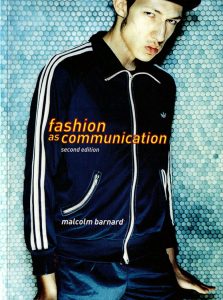 For the reflective writing task, I chose to read a chapter about ‘Etymology and the definitions of fashion and clothing’ from the Fashion as Communication book. This chapter explains the etymology of the word ‘fashion’, which comes from the latin word ‘factio’ which means making or doing something. The introduction of the chapter gave me an in-depth explanation of how the word ‘fashion’ relates to different terms. It looks into how associating words like “adornment”, “style” and “dress” can change the meaning of ‘fashion’.
For the reflective writing task, I chose to read a chapter about ‘Etymology and the definitions of fashion and clothing’ from the Fashion as Communication book. This chapter explains the etymology of the word ‘fashion’, which comes from the latin word ‘factio’ which means making or doing something. The introduction of the chapter gave me an in-depth explanation of how the word ‘fashion’ relates to different terms. It looks into how associating words like “adornment”, “style” and “dress” can change the meaning of ‘fashion’.
Reading through the chapter I came across the section about ‘Fashion and Anti Fashion’, which explains some of the aspects in which fashion takes place in the social and cultural status. The Royal family shows a good example of how they dress in a fashion and anti-fashion way. Taking into account Queen Elizabeth’s coronation gown which is an example of ‘Anti Fashion’. Polhemus and Procter suggests that it was ‘traditional’ and ‘fixed’ (Polhemus and Procter 1978). This is because the gown was designed for the “continuity” of her reign. Due to her high status, it is important that she is dressed anti fashion to show her position in the social scale, and remaining the same throughout the years to give a message of “continuity”. Whereas Princess Diana was described as “a one-woman advertisement”, she was seen as wearing “fashion”. I agree with the statement that she wears “it” as she has built an identity through the use of her own style and consistent image of a modern woman throughout her lifetime. I found a book that talks about dress and gender with a quote, “An emblem of peer, one’s position may be communicated by a crown, a staff, or a robe” which link quite well with the Queen’s “anti fashion” and her place in the social scale. I found another quote from a different book ‘Fashion Theory: An Introduction’ n it stated that “we have to use something with which to communicate and we must use something with which to construct ourselves as unique and individual member of cultures.” This also relates to Princess Diana as an example of someone who was widely known for her unique style and in which she used fashion to communicate with people around her.
Furthermore, a quote in the chapter that I thought was important “a garment is not an item of fashion until someone uses it to indicate their actual or ideal place in a social structure”, I feel that this stands in today’s western complex society, people who are in a higher status tend to use luxury fabrics and branded clothing. I noticed this links to Simmel’s idea of “primitive” and “civilised” society. In a place where there are social cultural groups there’s pressure in dressing right as opposed to “primitive” society where there is little pressure on expressing their individuality and in a way they’re all equal, therefore the way they dress would not be fashion.
Analysing further, I came across a part of the chapter which talks negatively about fashion, this was a quote written by Elizabeth Wilson found in The Guardian. “Fashion is trivial and ridiculous and serious minds need not to be detained by it”, this quote clearly dismisses fashion and doesn’t believe that it is a serious topic which I completely disagree with because fashion largely contributes to the UK’s economy.
Bibliography:
[1] Bardnard, M (2002) Fashion As Communication, London: Routledge
[2] Barnes, M and Eicher, J. B. (1992) Dress and Gender: Making and Meaning in Cultural Contexts. Vol 2. Oxford: Berg.
[3] Barnard, M., (2014). Fashion theory: An introduction. Routledge.
